Cringey and Ecstatic, Performa 2023 Captivates Audiences: A Collection of Brief Reviews

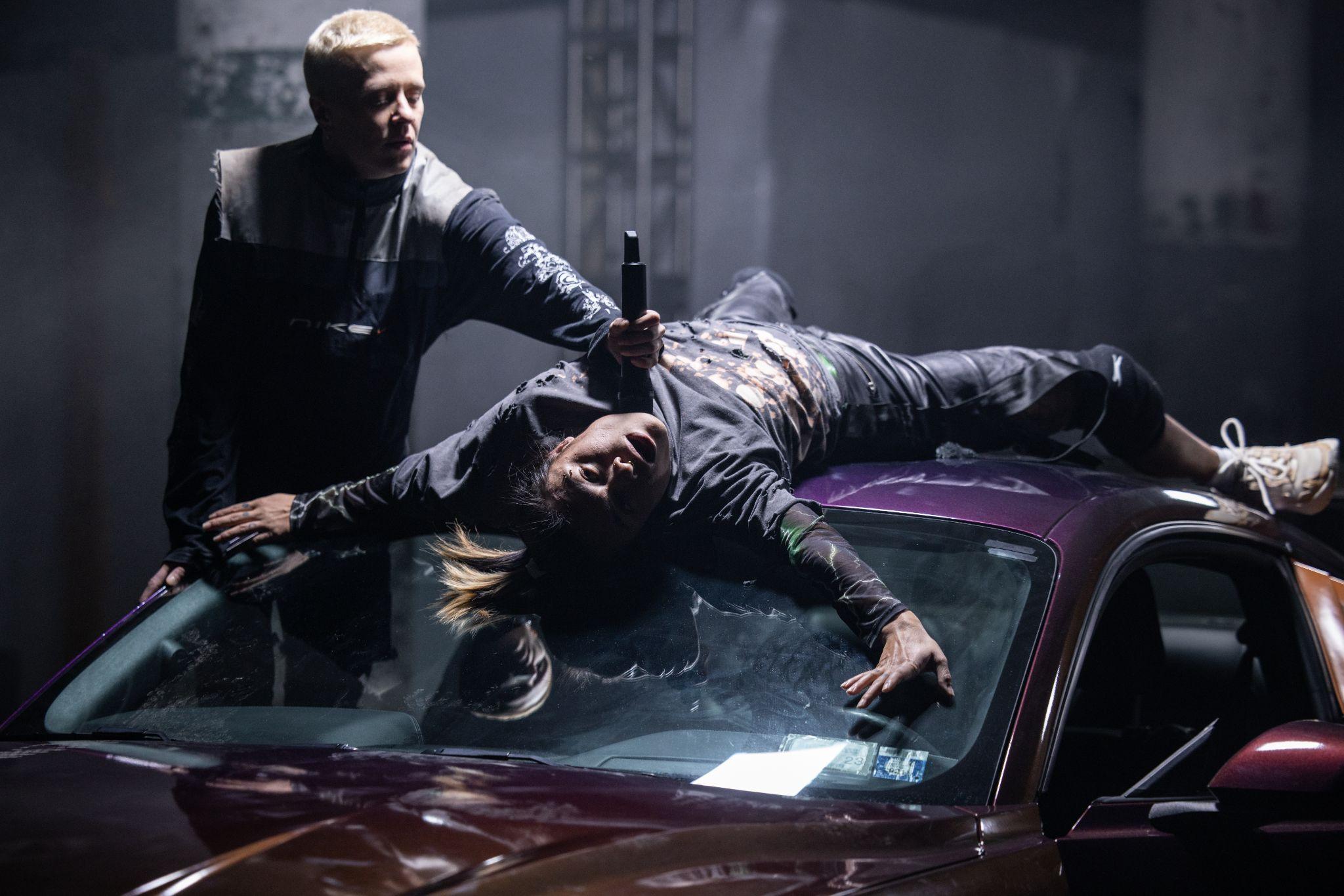
For its landmark 10th edition, from November 1-19 at venues across New York, Performa Biennial 2023 presented an ambitious program of live performances, talks, and gatherings. Among them, are a display of human-machine intercourse with a car, bodies connected through garments in the re-performance of seminal minimalist works, a monologue presenting a poignant critique on self-help culture, and a scholar framing echoes and listening as a form of resistance. As part of their Pavillions Without Walls section, this year’s biennial had a special focus on Finnish performance, dance, and sound-based artists. In addition, artists and scholars whose work and lives are political were spotlighted within the section ‘Protest and Performance: A Way of Life.’
Some might critique the biennial model as tired, but labeling a recurring art event a biennial indicates an ambition of magnitude and an attempt to secure relevance, it is an act to establish. There are only a handful of biennials focusing solely on performance art—Vilnius and Turku are among the other cities that host them—while multi-medium contemporary art biennials are plentiful. As performance art struggles to maintain its position within academia and the institutional art world biennials like Performa are pivotal in cementing its importance—and, given the amount of sold-out events, appreciated by audiences.
Reporting from the front row Anna Mikaela Ekstrand, Jenny Wang, Qingyuan Deng, and Carson Wos share their thoughts in the form of brief reviews.
Haegue Yang: The Malady of Death l Performa Commission
Curated by Charles Aubin. November 3-4 at Solomon R. Guggenheim Museum
I had never read the French auteur Marguerite Duras’ The Malady of Death, but for its early depiction of the Hiroshima bombing and, for the lovers’ vulnerabilities, an entangled love story that could only happen within that geo-political moment Hiroshima, Mon Amour had impressed greatly upon me. About her novels, I remember both male and female perspectives and dense descriptions of domesticity, responsibilities, and complex affairs. I must be missing something, I thought as I squirmed in my seat ten minutes into Haeugue Yang’s sixth staging of Duras’ novella The Malady of Death. What is going on? The setting was impressive a spotlight traveling across the circular theater and Noma Dumezweni from time to time occupying a different place on the stage as she reads parts of Duras’ novella while others are broadcasted on speakers through a lesser-quality recording. However, Dumezweni’s recording, real-life delivery, and presence did not keep my attention away from the drivel she was reading.
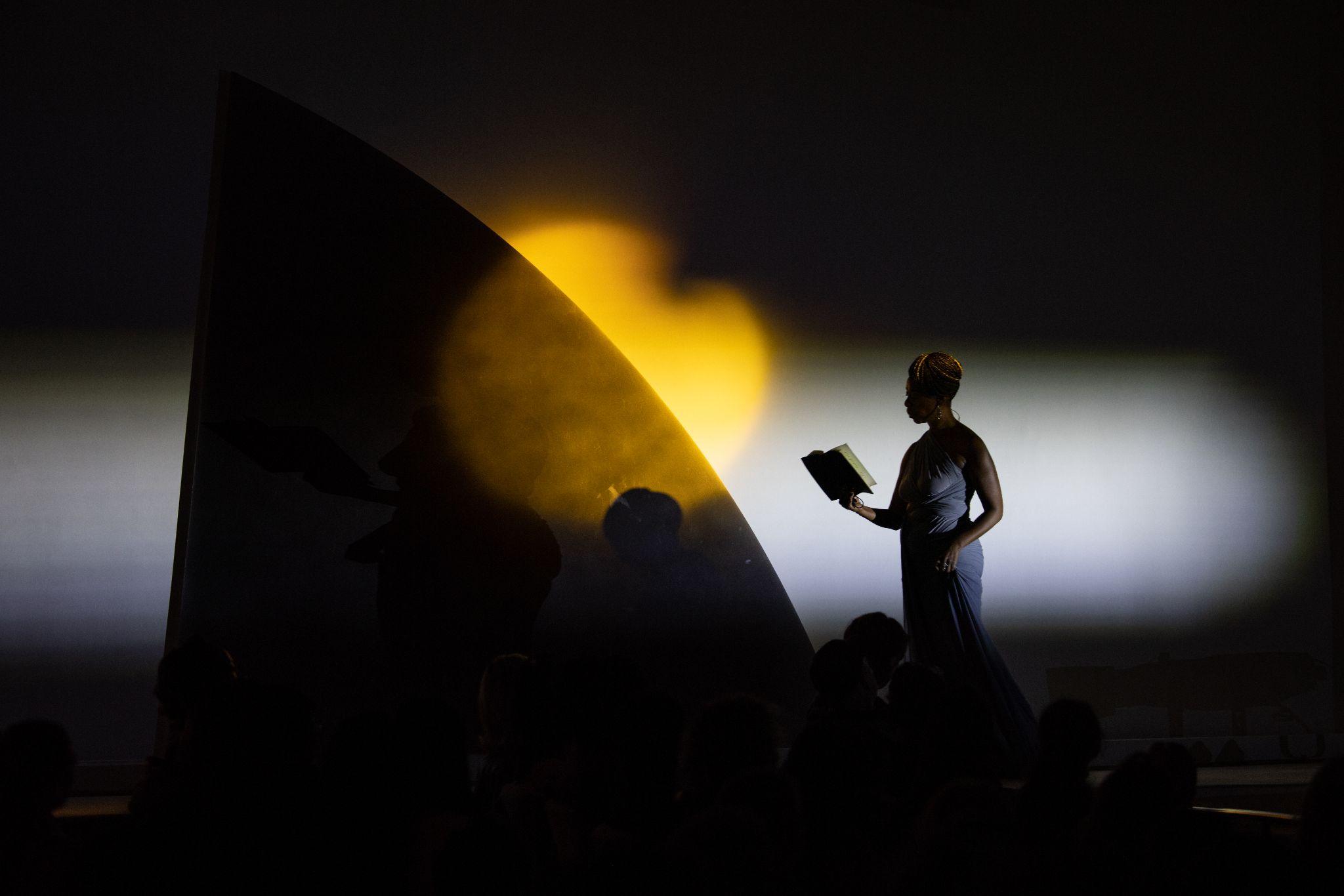
The novella takes place in a seaside hotel room, where a man, suffering from not being able to love, has paid a woman—not a sex worker, just a woman—to teach him how to love. She explains that his “malady of death” is incurable. The man cries, thrusts, and comes, and says he will never make a woman come again, but later makes the woman come. She is a conduit for his emotional journey which seems to be at a standstill. My mind wonders, will they ever eat, dress, or shower? Where is housekeeping? Nothing happens except sleep, sex, weeping, circular surface thinking, and some stilted conversation on death and loneliness. Duras’ wrote the piece in 1982. I try to picture that it might have been an important depiction of male vulnerability or depression, but I cannot—the overall text is filled with so much misogyny and fluff that I cannot grasp its depth.
– Anna Mikaela Ekstrand
Louis Chude-Sokei: History is Listening: Sound, Space, Race, and Memory l Keynote
Curated by Defne Ayas and Kathy Noble on November 4 at Performa Hub
Sound and performative lectures are both having a moment right now and Louis Chude-Sokei’s merged the two in his engaging keynote centered on echoes and new forms of listening. “As an immigrant, we are always listening and trespassing,” he explained. Within the field of confronting history, he aims to expand memorialization to not only incorporate tearing down or building monuments, and changing names of streets or birds but also to incorporate sound. The roots of his interest in sound stem from his biography, as a Jamaican—he stressed the importance of sound on the streets for emancipation, joy, and togetherness. Having published several titles, being the director of the African American and Black Diaspora Studies Program at Boston University and editor of The Black Scholar much of his succinct and eloquent writing on sound and culture is readily available. The scripted and choreographed talk with its interjections of sound added a dimension to the presentation of his recent project Sometimes You Just Have to Give It Your Attention, a multi-year sound art project at the Nazi Party Rally Grounds in Nuremberg, Germany.
When he was invited to respond to the Nazi Party Rally Grounds in Nuremberg he turned to listening as a form of protest. Building on ‘ruin-lust,’ and desire for wreckage, derived from the British novelist Rose Macaulay’s interest in WWII ruins, he explained that this preoccupation is especially relevant for those who do not have the possibility of wholeness. The colonized, displaced, or violated. “In ruin, cross-cultural understanding can occur,” he said. Therefore he invited various people to listen and respond to the “titanic and complicated space”—playing snippets from an Armenian violinist who had found a violin in an ex-SS soldier’s house during the visit, a Kurdish artist, and two Black sound artists who said that the site felt like their home in Nashville. Not only for its neo-classical architecture but for its delineation of the politics of the margins—the architecture made them feel small and like they did not belong, and were used to that. Poignantly, the echo carries with it repetition, mimic, and fading—Sokei-Chude paves the way for juxtaposing echo with memorializing which might be what we need to further process difficult shared and interlocking histories.
– Anna Mikaela Ekstrand
Søren Aagaard: Cafe Zero
Co-presented with Art Hub Copenhagen on November 8–9 at the Performa Hub
Diverging from the sterility of a commercial kitchen or the coziness of a countryside potluck, Danish artist, who is also a trained chef, Søren Aagaard’s “Cafe Zero” seems to be a place where food is unlikely to be prepared. Across the ceiling, garments like socks and pants hang across a clothesline. Tie-dyed with burned sienna and umber, they evoke an aesthetic of decay and dispersion. Behind the stainless steel work tables are two tents of the same fabric, illuminated with violet neon lights from the inside. Observing the visual metaphors of water stains and bacteria cultures, we find ourselves transported into a microscopic world where chef-performers wearing uniforms designed by Anne Sofie Madsen ignite conversations that create connections between being human and microbial.
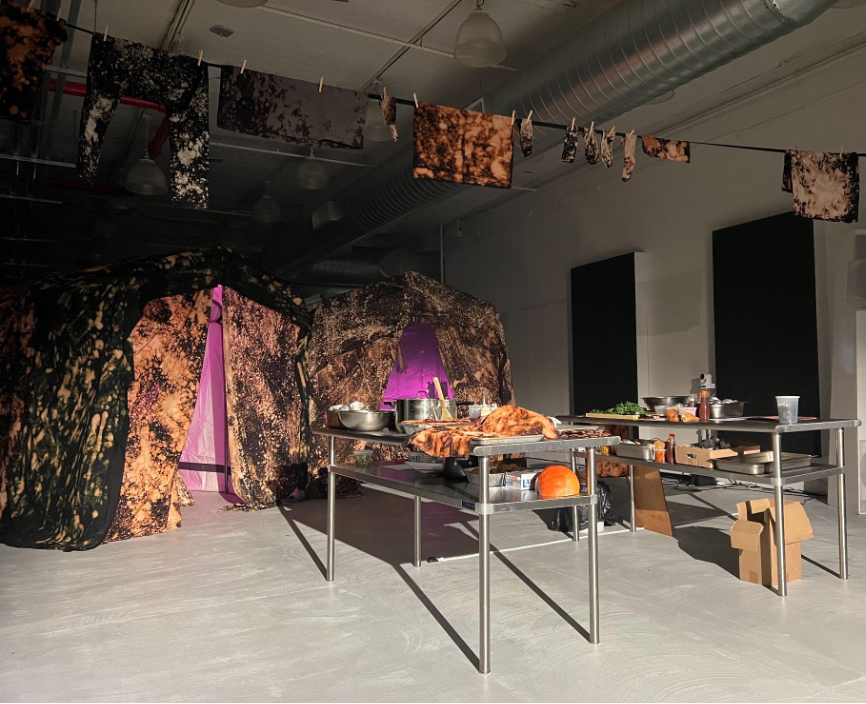
At “Cafe Zero”—similiarly to Rirkrit Tiravanija’s “untitled 1990” (“pad thai”) which runs concurrently st MoMA PS1—cooking and sharing food is expression, assimilation, and community-building. As the performers prepare dishes like pumpkin stew, beets, and oysters, the audience eavesdrops on random and seemingly spontaneous conversations about politics, science, and personal anecdotes inspired by certain ingredients or cooking techniques. They spoke about the Billion Oyster Project in relation to sustainable development and the fear and skepticism around antibiotic resistance. When the conversation becomes too formal an excited comment like “I love pastrami!” or surreal questions like “How do you think the future is going to smell?”pulls us back to the upbeat site of cooking and serving. They even cracked a diarrhea joke—comically unappetizing for a kitchen scene. Subtle hints suggest a parallel between labor in the hospitality industry and the continual chemical processes of fermentation. What Aagaard’s work makes clear is that the human body at work is just like a microbe: “Scrubbing, cooking, working, cleaning, smoking, fermenting every day.
– Jenny Wang
Nora Turato: Cue the Sun l Performa Commission
Curated by RoseLee Goldberg and Kathy Noble on November 9–10 at the New York Society for Ethical Culture
Cue the Sun explored self-fashioning in a society that has a voracious appetite for images and shiny façades. Poignant, expressive, and funny, Nora Turato barefoot clad in black and lit by a single spotlight monologuing on the stage revealed the deceit of self-optimization and extensive productivity management.

Without any sound effects, music, or colorful lights, Turato’s, or the character that she played, the initial question “Do you ever feel like something is missing?” led to “Like you, I want more”—the emblematic motto of a new-age hunger for success, self-betterment, and implicit interpersonal competition. According to the press release, Turato had worked with Hollywood voice coach Julie Adams in vocal and gestural training sessions involving neurofeedback, running, hypnosis, and holotropic breathwork to “remove herself” and let the character come to life. Her delivery was exquisite. As her speech escalated into a rapid-fire sequence of affirmations, working on oneself, healing, opportunities, work, and most importantly, “wanting more” the initial sermon on self-help became a comical spectacle of self-absorption. Words like “driven” appeared to be empty vessels of anxiety fueled by marketing. The omnipresent paranoia that exists just below the surface is best exemplified by the character’s rejection of toothpaste, mouthwash, and even tap water due to the fear of toxins. “It’s just not a way to live.”
Embodying the mixed personas of stereotypical influencers promoting gendered, capitalistic, and unrealistic content Turato’s character became a stand-in for Frankenstein of the 21st century. Most presciently, for those who grew up around social media, the pressing urge to discard an “undesirable” version of themselves has likely led many to internalize behavioral/thought patterns predicated upon self-hatred, instead of empathy.
– Jenny Wang
Teo Ala-Ruona: Enter Exude I Finnish Pavilion
Curated by Job Piston, November 10-11 at 154 Scott Avenue, Brooklyn
Teo Ala-Ruona presented a truly electrifying experience that explored the human-machine relationship in late capitalism through a queer lens. It constituted a memorable “somatic psychological process” that proposed a radical reimagination of erotic, commercial, and ecological value systems.
Complicating how sexuality, gender, fetish, posthumanism, and technology intersect, the show was set in a garage. It began with Ala-Ruona and co-performers Raoni Muzho Saleh and Charlie Laban Trie whispering elaborate breathy declarations in adoration of the car such as: “The car is like a sex god” as pink, psychedelic neon lights and pseudo-80s soft-porn elevator music transported us into an erotic dream. A sense of immediacy was created when the performers weaved through the audience, at times, rubbing up against in a state of utter adoration and discomforting entrancement, describing sexual acts in automobile terms. We witnessed their total submission to the metallic, phallic allure of the car, whose appeal as a luxury commodity was turned into an anthropomorphized sexual fetish. Just as this display of erotic desire was starting to feel lengthy, a little too much, a rumbling noise spilled into the space as a mechanic door rolled open and a high-performance sports car entered the stage.
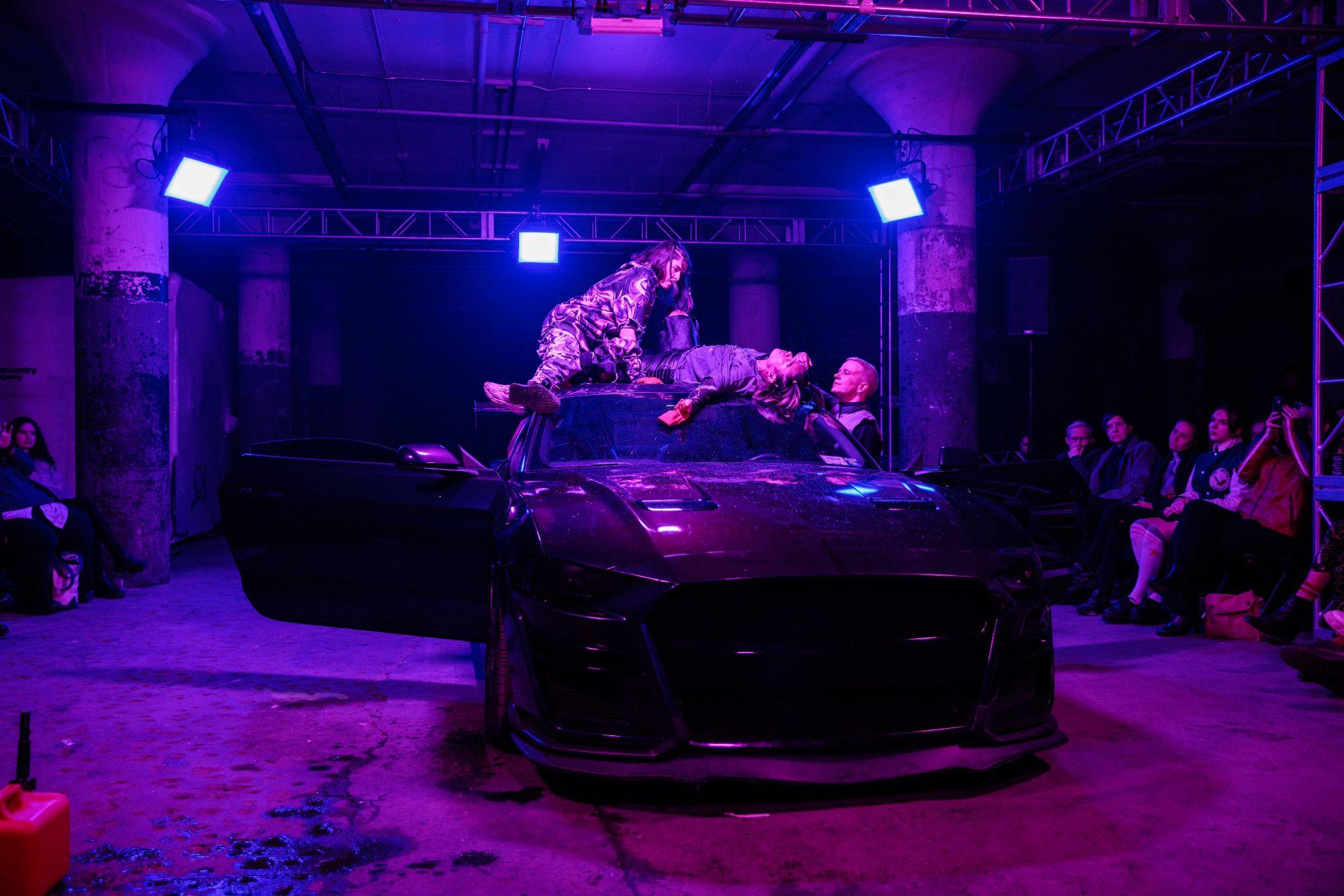
Enlivening their previously described sexual fantasies, the performers started to fuck the car. They licked and fondled its shiny mirrors and windows, which quickly escalated into their smoking from a siphon pipe, drinking out of a gasoline can, licking people’s boots, and rocking the car up and down ecstatically. Yet again, the room was carried away into an intense, sweaty collective orgy predicated upon the eroticism of the non-human parties. Skillfully moving into societal critique as they through a natal and Freudian lens narrated the power dynamics of the car within their own nuclear family; as a symbol of manhood, impressed upon them as young boys illustrated by their erratic darting around playing with toy cars. Dream quickly turns into a nightmare as they realize that petroculture is killing the planet, suffocating them. The performance reaches its climax against a hazy apocalyptic yellow glow—the closing scene of Blade Runner comes to mind—the performers’ trembling bodies and robotic voices rapidly utter “It’s a dream, it’s a dream, it’s a dream…” The explicitness was unhinged; I wondered how the subconscious mind, sexuality, and fetishization intersect with theories of madness.
– Jenny Wang
Marcel Dzama: To live on the Moon (For Lorca) l Performa Commission
From the opening night on November 11 at Abrons Arts Center, Henry Street Playhouse
Distilling the aesthetic framing and canonical tropes of Dada, Marcel Dzama pays homage to an earlier performative moment without maintaining any of its original destabilizing punch. Akin to a theatrical revival, this first-for-the-artist begs the question of the period’s continuing cyclical resonance with the violent quandaries of our current era. For an erudite viewer, thin wisps of a continuum subtly exist, though such a heavy emphasis on the original inspiration feels more of an institutional crutch than an impactful reinvestigation of the movement’s critique anew in light of global politics today.
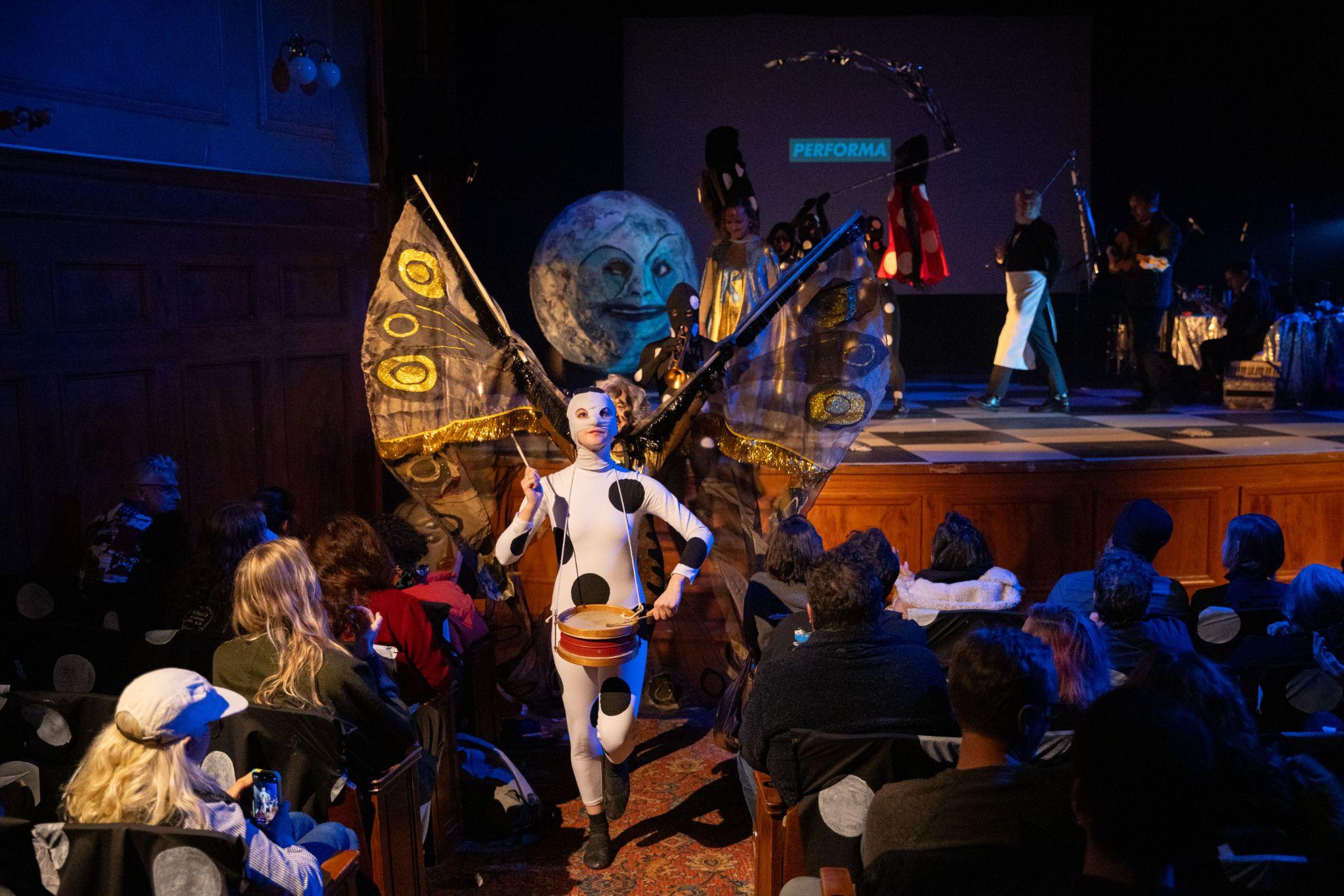
Polka-dotted seats, flinging stuffed dead fish, coiled spring fingers, and multi-generational performers set the scene for To Live on the Moon. Part film-noir whodunnit video art screening, part 1970s rock happening, part live orchestration of an original moonlight-inflected concert accompanied by Spanish narration of Federico García Lorca’s poetry by his daughter—Laura García Lorca: a viewer could lose themselves in the myriad layers of quotations Dzama is drawing upon. Opening with a full band serenade dripping with Wes Anderson-esque quirky-camp, the centrality of the moon in these proceedings was made paramount in the presence of a human-sized papier mâché of the ‘man in the moon’ mirroring the song’s lyrics. Utilizing silver lame uni suits, a twinkling score of steel drums and jingle bells, Dzama’s staple polka-dotted performers—the circular repetition elevating them to constellation-like camouflage for the stage manager’s technicians—, and many seemingly nocturnal characters took the stage. Buoyed overall by the cheerful waving hellos of the young middle-school-aged supporting actors, the opening evening felt like a community-focused endeavor bringing people together akin to a school play; fun but lacking in conceptual rigor.
– Carson Wos
Gregg Bordowitz and Pamela Sneed: Healthcare Not Warfare: A Tragi-comedy l Protest and Performance
November 17 at Performa Hub
If language is the performative medium and authorization of power, as many feminist and queer theorists have stipulated, then the most promising start to tear down the postcolony lies in declaring one’s refusal of its legality and legitimacy. In Healthcare Not Warfare: A Tragi-comedy, a one-night-only event organized by Gregg Bordowitz and Pamela Sneed, poets, librarians, comedians, and performers led a counter-hegemonic revolution against the military-industrial complex.
Bordowitz and Sneed’s opening remarks set the tone for the gathering: a trenchant critique of various systems of oppression at home and abroad that is at the same time playfully irreverent and militantly committed. A Zoom conference led by Filipinx no-binary poet Kay Ulanday Barrett soon ensued. Their unpretentious, witty poetry speaks truth to the urgent demand for disability justice in the context of America’s failed management of the Coronavirus pandemic with its consequences disproportionately affecting already marginalized communities. Following Barrett, comedian Morgan Bassichis swiftly improvised a participatory comedy that passionately demands the enthusiasm of audience members. Bassichis shouts “Go on Grindr” or “Thank God” and his chant is completed by the collective vocalization of “To call your reps” or “For abortion” beneath the stage. The imperialistic project of military intervention and dismantling reproductive justice edges on dissolving in the queer call-and-response of laughter and dissent.
After Bassichis, activist OlaRonke Akinmowo gave a town hall-style presentation on her brainchild The Free Black Women’s Library, where the simple act of resting, playing, and reading literature produced by black women harbors possibilities of liberation. Choreographer Miguel Gutierrez then guided the audience through a dance piece that hinges on physical contact between strangers, evoking the fear of touch at the height of the AIDS epidemic. Viva Ruiz, dressed as a cam girl in papaya drag, bookended the night with another dance, where two sexy angels were her backup dancers. Moving around the stage, Ruiz seductively insisted on the normalization of abortion and an end to America’s hawkish foreign policy. In their closing speech that channels the long history of art-as-activism (think of Sisters of Perpetual Indulgence), Bordowitz and Sneed suggestively hinted at how the ecstasy of communication afforded by such explosive multiplication of language throughout the night could be harvested for liberatory subject formation. During the event, the arbitrary boundary between performance and activism, marked all the more porous by a recent genealogy of socially engaged art, could no longer sustain itself.
– Qingyuan Deng
Franz Erhard Walther: Creation Needs Action (Program C)
Curated by Charles Aubin presented on November 17-19 at Judd Foundation.
Upon entering, the street-level gallery of Donald Judd’s historic home the lack of clear vantage points caused the audience to cower and search the room for additional clues or familiar faces. Then, without ceremony or proclamation, one communal inhale signals the commencement of Franz Erhard Walther’s first performance of the evening. In Eleven Meter Path (1964) performers wearing connective apparel—part costume, part prop—on the edge of a rectilinear 11-meter-long drop-cloth, which flips the palpable action onto the whisper-filled and craning crowd in a Cagian or Morrisian nod. Archival precision and care are taken to handle by gloved and merely socked technicians maintaining museum-like reverence for the garments. Their sneakers were placed in the alcove of a piece of Judd furniture before the show began. The maestro, Walther, sits atop a stool inhabiting a throne-like axial and unobstructed view of the proceedings to be imbibed—casually calling the name of the work and the year it was first performed, sometimes also gently directing the performers.


Two peripheral bodies connected over structurally defined distances is a recurring theme of the evening. Labor blending boundaries reveal performers as dressers and object handlers as nearly more performative in their professionalism than each performer themselves. These deconstructive principles allow the conceptual framework of the work to remain paramount, as opposed to the able execution of performance that entirely lacks a fourth wall as a theatrical haven. This becomes explicit by a selection of participants in With Direction (Six) (1966) joining beneath a canvas—for a moment, it is unclear whether they are audience members or significant contributors to the project. Spanning a variety of ages, ethnicities, and sartorial statements perhaps these cocooned forms—just faces visible—are a snapshot of our world today. Each participant instantiated the fact that unity despite these traditional hurdles to communal respect or dedicated action is simple to achieve in our society. Regardless of the perceived hurdles or false narratives of division that persist today. Asleep on the floor? Or swaddled each lifeless in a unified shroud? The intention of the artist remains indeterminate. Though this seminal piece debuted at MoMA in 1966 it still enacts a similar clamor of difficult-to-receive directionless insecurity ebbing and flowing in ripples across all observers. Unconsciously fulfilling the activation of this trope (Like moths to a flame) the onlookers gurgle into conversation with their “new neighbors” as the performance itself becomes a unifying framework uniting us all in mutual inquiry and—if deeply listening—understanding as well.
The reprisal of these happenings is a memorial to the moment of the 1960s minimal conceptual performance that continues to invoke a very corporeal response; they make our bodies a structural unit—separate yet connected—within the continuum of the historical lineage of humanity itself.
– Carson Wos
Niko Hallikainen: Lavender Deal I Finnish Pavillion
Curated by Job Piston on November 18-19 at Tibet House
Appropriated recordings from 1970s and 1980s media, haunting ambient music, burning incense, and Beat Generation poetry merged into a quasi-metaphysical séance that attempts to answer questions with no immediate resolution: Can the present world, with all its fragility, contain the multitude of drives implicated in radical love? What about Uranus? In his durational performance that lasted for 80 minutes, Niko Hallikainen unemotively read from his phone next to a site-specific shrine and a sound mixer in the dark-lit gallery, without pause or break.

Listening attentively to the stream of autobiographical details and theoretical musings, I was able to make out the melancholic contours of a romantic encounter that never ran its course. Under lockdown in 2020, Hallikainen met Carlo of Milan at Clubhouse. Over Zoom, a long-distance love affair took shape, in the spirit of transnational coupling advanced by other queer artists, such as John Giorno and Ugo Rondione and David Wojnarowicz and Jean Pierre Delage. Tales of cybersex (“Can we ejaculate together?” Carlo wonders at one point) were interwoven with self-reflexive pondering on the fantasy of unmediated intimacy (Could Hallikainen feel the empty streets of Milan from the comfort of home Helsinki?), a fantasy nevertheless rendered precarious by our technologically-saturated pandemic life. When the lockdown was lifted, Carlo turned down Hallikainen’s offer to take a flight to Helsinki and they never met in person. The queer grief of unresolved longing, best manifested in the last email exchange between the two that led to nowhere, transmuted into mystical and cosmic meditations on love and loss.
– Qingyuan Deng
You Might Also Like
Nikita Gale Loosens Attitudes Around Sound With Her Performa 2023 Commission
Delfina Foundation to Present Performances at 2019 Venice Biennale

